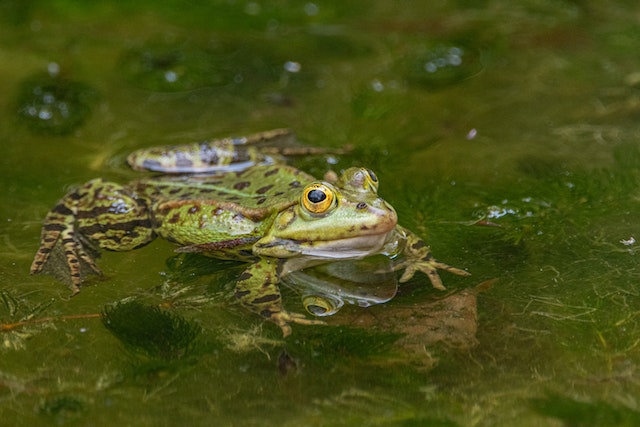
How do amphibians breathe underwater? They breathe through their skin.
The word “amphibian” comes from the Greek amphi, meaning both and bios, meaning life. The word was first used in the 1630s and it was used to mean animals that “have two modes of existence”. There are about 7,000 different types of amphibians in the world today. Close to 90% of them are frogs and toads, but there are also salamanders, newts, and caecilians. Amphibians can breathe both above and below water. The majority of them have to lay their eggs in freshwater because their eggs don’t have a hard shell.
As humans, we obviously breathe using our lungs. We take oxygenated air in through our noses, it goes down into our lungs and into the 480 million or so alveoli, which are tiny sacs. The alveoli are lined with tiny blood vessels and the oxygen passes from the air into those blood vessels. At the same time, carbon dioxide is released from the blood vessels back into the alveoli, and it is breathed out through the nose.
Fish breathe using their gills. They breathe in a very similar way to us, except they take the oxygen out of the water, rather than out of the air. As they swim, water passes through the gills. The gills serve the same purpose as our alveoli, and they are covered in tiny blood vessels. The oxygen from the water passes into these blood vessels and carbon dioxide is released at the same time.
So, knowing how air breathers and water breathers take in oxygen, how do amphibians breathe underwater? They do it through their lungs and they do it through their skin. Most amphibians have lungs, although they lack a diaphragm. They draw air into their lungs by breathing in, blocking their nostrils, and then forcing the air down to their lungs by using their throat. That’s why a frog’s throat swells up when it is breathing. The air reaches the lungs, and the oxygen is absorbed in the same way that ours is. The oxygen diffuses into their blood much more slowly than ours does, and they have a very low metabolism.
When they are underwater, they take in oxygen through their skin. They have very thin skin and a lot of blood vessels very close to the surface of it. When they are underwater, the blood vessels take oxygen out of the water, in the same way that a fish’s gills do, and release carbon dioxide back into the water. However, most amphibians cannot breathe this way permanently. Frogs can usually stay underwater for about 4 to 7 hours before they have to resurface to breathe. And if they accidentally breathe water into their lungs while they are underwater, they can drown. So, most amphibians are not technically able to live in both worlds. They can stay underwater for long periods of time, but they do have to resurface. If they suddenly have to escape a predator, they will use more oxygen than usual and they will probably have to resurface sooner. Amphibians that have more wrinkles in their skin than other amphibians can stay underwater for longer because the wrinkles increase the surface area of their skin and mean they can take in more oxygen.
When amphibians are above the water, they still breathe through their skin as well as their lungs. Their skin has to be wet to allow the oxygen to pass into the blood vessels. Amphibians produce a mucus through their skins to always keep it moist. This is one reason why it is not a good idea to pick frogs up. Their skin is very thin, and you can wipe the mucus off with your hands.
Some frogs hibernate at the bottom of ponds. They can bury themselves in the mud and stay down there for several months during the cold winter months. They do this by slowing down their metabolism to almost zero. They burn almost no energy and need almost no oxygen to stay alive.
Not all amphibians are the same. The Titicaca water frog and the hellbender salamander live in cold, fast-moving streams and they breathe mostly through their skin. The lungless salamander, as you have probably guessed from its name, has no lungs and breathes entirely through its skin.
So, how do amphibians breathe underwater? They breathe through their skin, although they cannot take in enough oxygen this way to stay underwater permanently and they have to resurface to breathe properly after about 7 hours. And this is what I learned today.
Sources
https://www.iowadnr.gov/About-DNR/DNR-News-Releases/ArticleID/1454/How-do-fish-breathe
https://kidshealth.org/en/teens/lungs.html
https://pubmed.ncbi.nlm.nih.gov/14512270/
https://www.earth.com/earthpedia-articles/how-do-amphibians-breathe/
https://www.etymonline.com/word/amphibian
